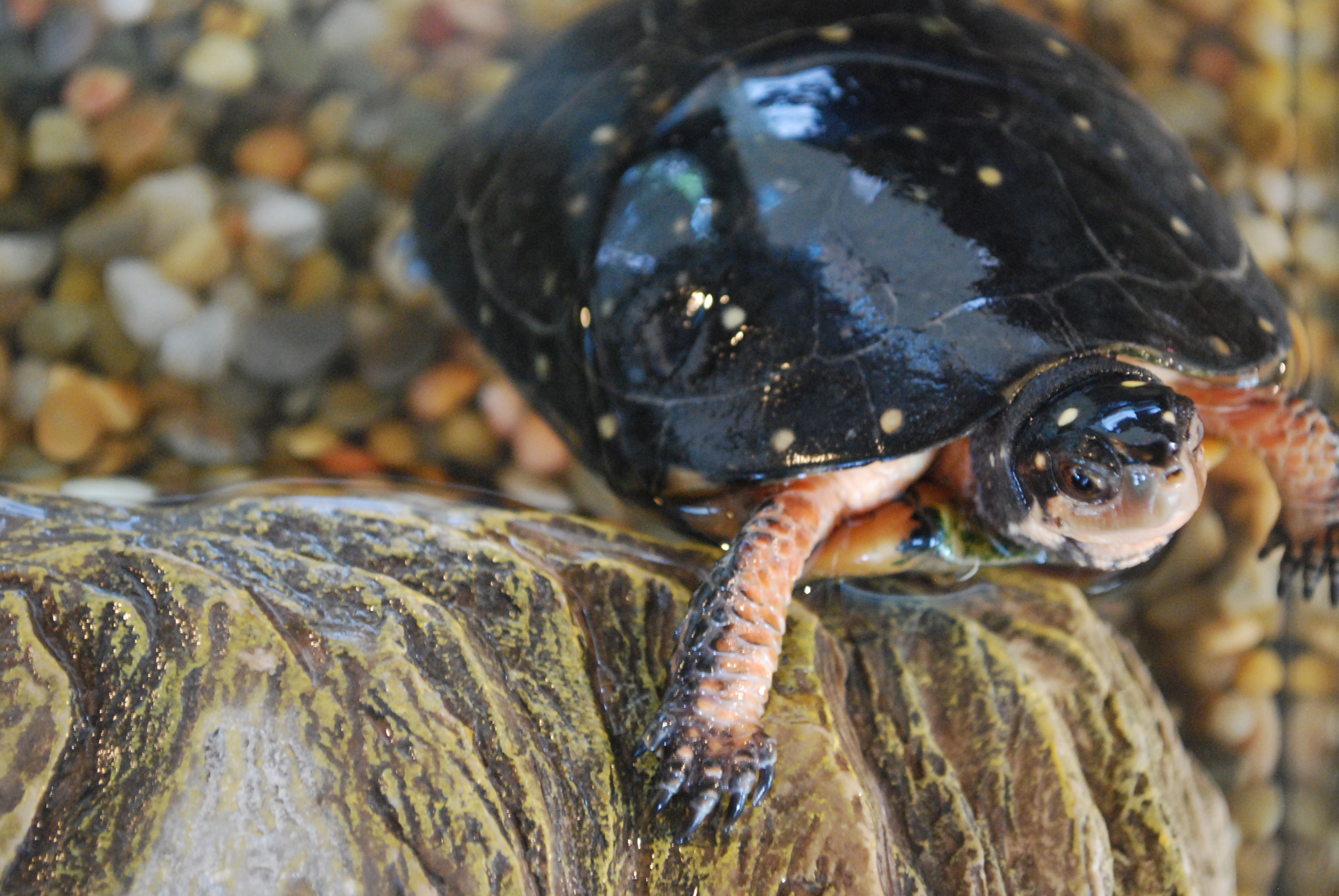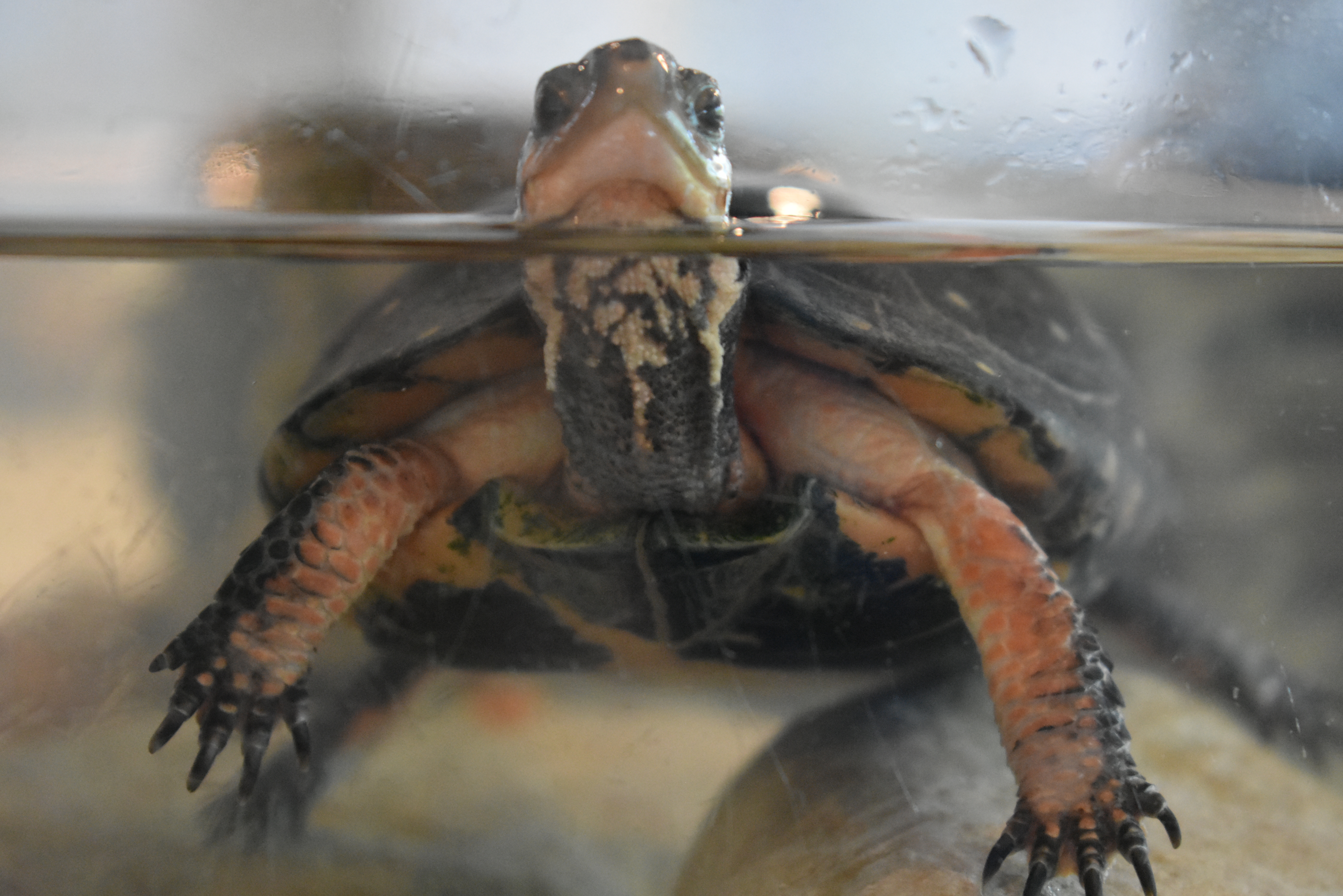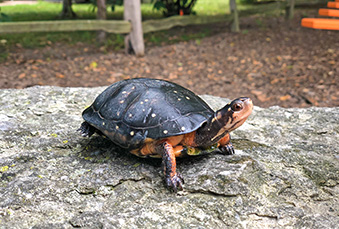Clemmys guttata | Spotted Turtle
Name: Petoskey (Female)



Meet Petoskey
Though small in size, Petoskey the Spotted Turtle has a big role to play in the conservation conversation! Native to the eastern United States and Great Lakes region, Spotted Turtles are semi-aquatic reptiles that are crucial to the health of wetland ecosystems. While Petoskey is currently living behind the scenes, this endangered turtle has an important story to share—from disappearing habitats to clever camouflage and summertime snoozes!
Life in the Wetlands
Spotted Turtles thrive in quiet, forested wetland habitats, including:
- Swamps
- Vernal Pools
- Bogs
- Marshes
- Small Streams
- Wet Meadows
These lush, vegetated environments offer protection from predators, access to food, and safe nesting grounds. Spotted Turtles are named for the bright yellow spots scattered across their dark, dome-shaped shells. These spots provide excellent camouflage, mimicking the dappled light filtering through their watery homes.
Size: 3.5–5 inches long—roughly between a standard sticky note and a computer mouse.
Each turtle’s pattern is unique, with anywhere from 0 to over 100 spots, which may change over time!
Spotted Turtles are sexually dimorphic, meaning males and females have noticeable physical differences:
- Females are generally larger, with a higher, rounder top shell (carapace), orange eyes, shorter, thinner tails, and yellow or orange chins.
- Males tend to have a flatter, more elongated shell, brown eyes, longer, thicker tails, and darker chins.
What's for Dinner?
Spotted Turtles are opportunistic omnivores, feeding on a variety of small, edible items they find in the wild, including:
- Algae and aquatic plants
- Mollusks
- Crustaceans
- Worms
- Insects
- Amphibian eggs
- Carrion – animals that have already passed away
At the zoo, Petoskey enjoys a carefully curated diet of:
- Mazuri freshwater turtle diet
- Fish and shrimp
- Crickets and other insects
- Fresh produce
Aestivation: Summer Survival Mode
While many people know about hibernation (a winter dormancy), Spotted Turtles also slowdown in the summer! When temperatures rise, they enter a state called aestivation—a warm-weather rest period where they burrow into leaf litter, mud, or animal tunnels to stay cool, conserve energy, and avoid predators.
This adaptation helps them survive seasonal dry spells and heatwaves—an impressive feat for such a small reptile!
Where’s Petoskey?
While Petoskey isn’t currently out for everyone to see, this little ambassador plays a big part in educating visitors about freshwater conservation. Through behind-the-scenes care and outreach programs, Petoskey helps raise awareness about the importance of protecting wetland habitats and respecting wild animals—especially those vulnerable to human impact.
Turtle Tidbits
- Turtles don’t have teeth—Petoskey uses a sharp beak to slice food!
- Their shell is part of their skeleton and is fused to the spine and ribs.
- They use a single opening, the cloaca, for reproduction, waste—and even breathing underwater in some species!
- Spotted Turtles are among the smallest freshwater turtles in North America.
Fact Sheet
Taxonomy
Species: Clemmys guttata
Kingdom: Animalia | Phylum: Chordata | Class: Reptilia | Order: Testudines | Family: Emydidae | Genus: Clemmys |
Favorite Enrichment Type
Mirrors, floating plants, floating toys, coffee can lids, and new hides!
Life Span
- In the Wild: 25 to 30 years
- In Human Care: 20-30+ years
Diet
- In the Wild: Algae, aquatic plants, mollusks, worms, crustaceans, larval and adult insects, amphibian eggs, and carrion.
- At the Zoo: Mazuri® freshwater turtle diet, fresh produce, fish, shrimp, insects such as crickets.
Geographic Range
There are two distinct populations one on the East Coast of USA from Southern Maine to northern Florida, with isolated populations in Quebec, northern Vermont, and western Carolinas. The other in the Great Lakes Region from Illinois to New York, with isolated populations in Indiana and Ontario.
Habitat
Found in early and mature forests that include many different wetland types, that include swamps, bogs and marshes, wet meadows, and vernal pools.
Status: Endangered
Conservation Matters
Spotted Turtles are currently listed as Endangered by the IUCN, with populations declining due to several serious threats:
- Habitat loss from wetland drainage and development.
- Illegal collection for the exotic pet trade.
- Road mortality while searching for nesting or feeding sites.
- Climate change, which disrupts hatching success and habitat stability.
Another challenge to their conservation is their slow reproduction. Spotted Turtles don’t reach sexual maturity until they are 7 to 14 years old. This means that populations take a long time to recover from losses, making protection efforts even more critical.
Why are Spotted Turtles important? Despite their tiny size, Spotted Turtles play an essential ecological role, helping to control insect and invertebrate populations. Their health closely reflects the condition of their environment, making them valuable bioindicators—species whose wellbeing signals the health of their ecosystems.
Unfortunately, their small size also makes them targets for the pet trade. However, Spotted Turtles do not make good pets. They require highly specialized care—proper lighting, filtration, supplements, and veterinary expertise—all of which can be time-consuming and costly. In many areas, collecting them from the wild is also illegal.
If you’re interested in reptiles, we encourage you to support the Not-a-Pet campaign to learn why turtles like Petoskey are better left in the wild. For experienced reptile keepers, adopting from a reputable rescue is a responsible way to give a turtle in need a loving home.
How You Can Help
You don’t have to be a biologist to make a difference! Here are a few ways you can help protect turtles like Petoskey:
- Support local and national wetland conservation efforts.
- Avoid littering, and never pour chemicals down storm drains.
- Watch for turtles when driving near wetlands and wooded areas.
- Never take turtles from the wild or purchase wild-caught pets.
- Support zoos, aquariums, and rescues working in turtle conservation.
Every action, no matter how small, helps protect the fragile ecosystems that turtles depend on.
How to Find Me
Petoskey is a member of our Ambassador Animals that live behind the scenes! If you would like to meet Pete in person, check out our daily, 11:00am Amphitheater Presentations at the Awareness Amphitheater, located just beyond the covered bridge. Amphitheater Presentations are dependent on the weather. Please check our activity board, behind the Admissions booth, before coming to see us!
